Customer Eats Sushi and Maybe Eat Sushi Again After It Nearly Waalks Off the Plate

Food in Japan: 32 Pop Japanese Dishes You Need To Endeavor!
Appointment published: 27 April 2020
Terminal updated: 27 Nov 2020
Japanese cuisine is globe-famous, only there is so much food in Japan to try besides sushi! Of course, many of us also know of sashimi, tempura, and ramen. Withal Japanese food culture is much richer than that.
So when visiting the land, what food in Japan should exist on your bucket listing? To aid you decide, we've compiled this list of 32 tasty Japanese foods that everyone needs to attempt.
i. Buta-No-Shogayaki (Ginger Pork)

This is ane of the well-nigh common (and tasty) Japanese dishes. Effort it in many restaurants, izakaya (traditional Japanese eating house/bar), fast food chains, and fifty-fifty as a bento box (a pre-prepared Japanese style lunch) found in many grocery stores and convenience stores.
The word yaki means literally "grilled." This dish is prepared by grilling thin slices of pork dressed with a delicate sauce of mirin, soy sauce, sake (Japanese rice wine), granola oil mixed with sliced onions, and ginger.
The dish makes for a great quick and tasty repast, and information technology's perfect for any flavor.
two. Champon
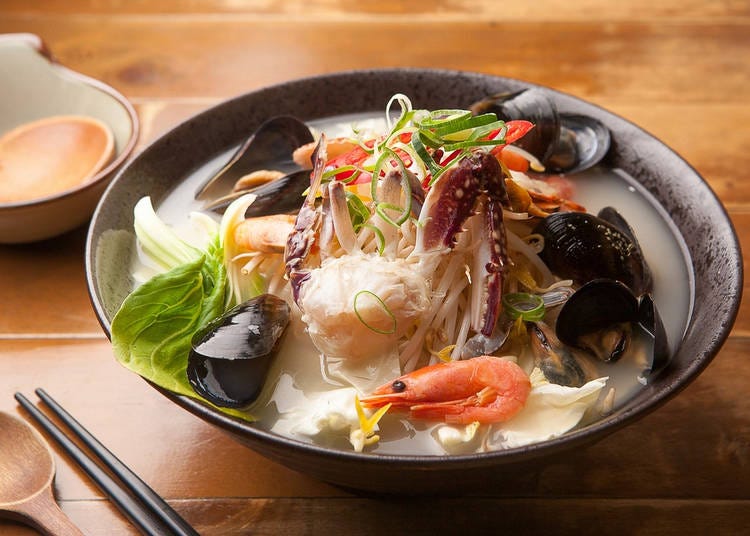
This dish may expect similar ramen at get-go sight (and you could say it belongs to the same category), merely information technology's different and unique. So if you lot desire to gustation something traditional, don't miss out on this dish.
Champon is originally from Nagasaki, every bit it start appeared there in a Chinese restaurant during the Meiji era (1868-1912). Notwithstanding, dissimilar the many different kinds of ramen, its noodles (specifically made for this dish) are boiled in the soup itself instead of beingness added later on.
A cracking seasonal dish, Champon'south ingredients vary slightly depending on the season (pork, seafood, vegetables, or whatever combination of these).
The ingredients are fried in lard, and a soup of chicken and pig bones is after added. The result is a robust and satisfying taste that is rarely the aforementioned. In fact, not but tin different versions of this dish be found in many countries in Asia, but also within Japan. This creates a multifariousness of unique styles and flavors that will keep you wanting more!
3. Edamame
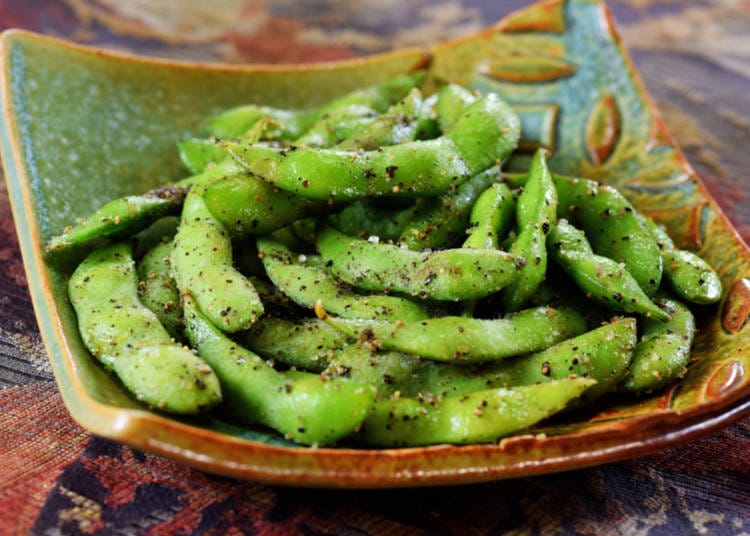
Okay, and so they're non really a dish, but they are a wildly pop food in Nippon. These are not yet mature soybeans, still in their pods. They can be served hot or cold (at times grilled instead of boiled) and are usually dressed just with salt. Edamame make for an amazing titbit.
Endeavor a few, and you volition find yourself reaching for more and more before yous know it. Edamame usually back-trail a repast in all izakaya, just they are most always role of the menu in the vast majority of Japanese restaurants in Japan.
4. Fugu
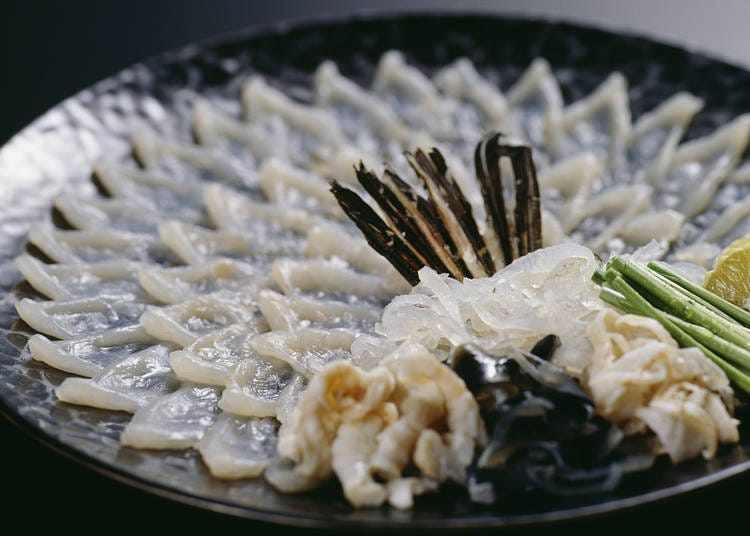
For those looking non merely for amazing food in Japan, but besides for a thrilling experience, fugu is the dish to try!
The fugu is a pufferfish that is, yes, succulent, but information technology can also be lethal due to a toxin in some parts of its body. Fugu is usually served as sashimi or in sure kinds of Japanese nabe hot pots.
The training of this fish, due to its characteristics, is rigidly controlled past the Japanese government. Chefs who aspire to prepare this fish must undergo at to the lowest degree three years of very rigorous training to go their license. Earlier being served, the toxic parts of the fish are removed, making it rubber to serve.
Interestingly, fugu liver is considered the tastiest part of the fish, but information technology'south also the one that can be the most poisonous. As a effect, serving fugu liver was outlawed in Japan in 1984. Should you effort this dish, you lot'll certainly remain amazed by its taste, only do careful research earlier ordering information technology in a restaurant (and never try to prepare it by yourself).
5. Gyoza
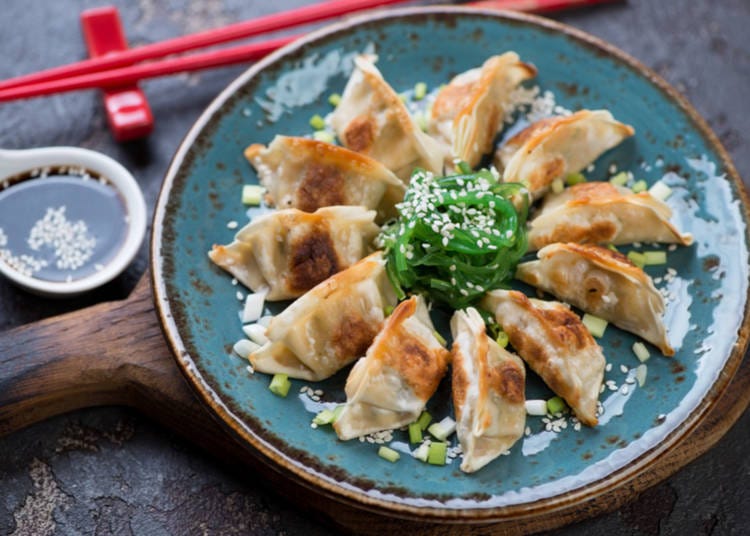
Gyoza are moon-shaped dumplings. Some other ane of those dishes that tin can be found in near every Japanese restaurant, regardless of their style, but that many people miss. Although Chinese in origin, the varieties yous'll discover during your Japan stay are often quite distinct from the original.
Gyoza comes in several varieties in Nippon. One of the most popular is "yaki-gyoza": the dumplings are prepared with a filling of minced pork meat, cabbage, garlic, onion, and ginger. They are then lightly fried until they become crunchy and of a squeamish dark-gold color.
Enjoy them with a dip made with soy sauce, rice vinegar, and spicy oil.
half-dozen. Gyudon
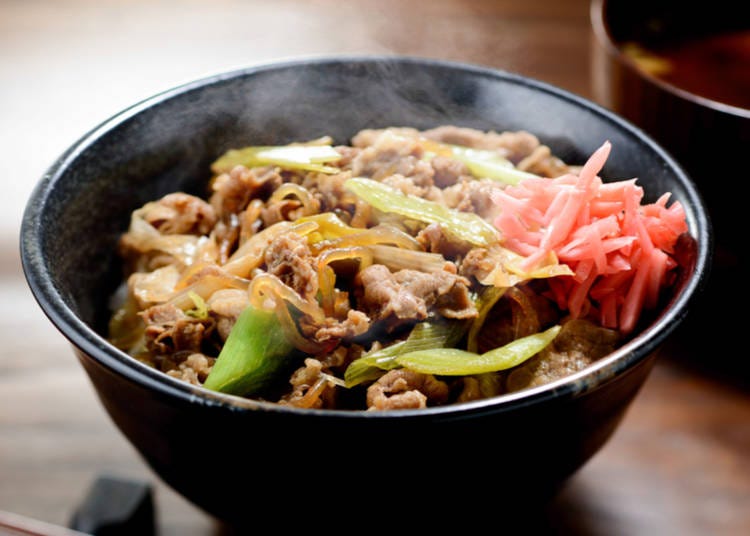
Gyudon is a rima oris-watering i-dish repast of beefiness over rice (gyu = beefiness). Gyudon is a quick repast served in specific restaurants or Japanese fast-food chains such as Yoshinoya.
A bawl of steamed rice is topped with thinly sliced beef and tender onion, simmered in dashi broth (a popular Japanese ingredient) and seasoned with mirin and soy sauce. Sometimes it'south served topped with a lightly cooked egg.
If you want to experience a typical Tokyo office worker'south lunch break, savor this quick and tasty dish and go back to your tasks (although y'all probably won't be needing to become to piece of work, you'll definitely savour having more time to sightsee and explore on a full and satisfied stomach).
7. Gyukatsu (Beef cutlet)
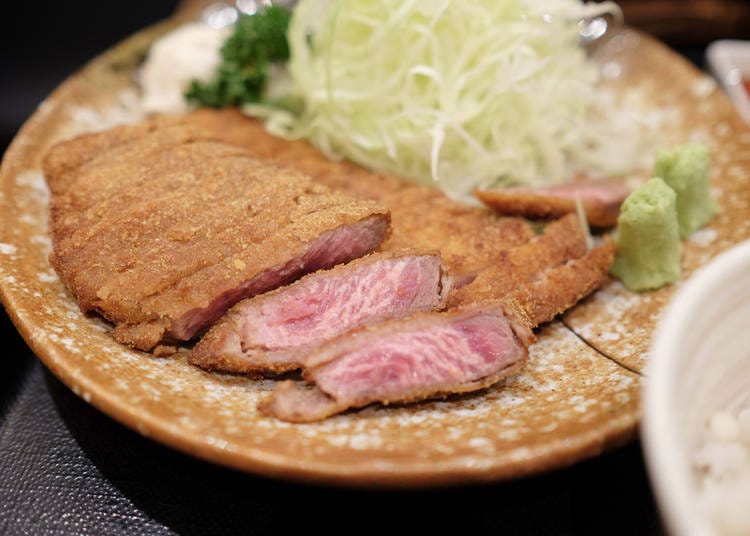
A wonderful beefiness variation of the popular pork-based tonkatsu (which we likewise recommend yous endeavour) is a dish of deep-fried breaded beef, usually served with cabbage, barley rice, miso soup, and spud salad, and pickles.
The grooming makes for a tender and crunchy texture and a very flavorful but not overwhelming taste. You won't find this dish equally easily as its pork analogue, only if you do, you'll be happy!
8. Gyutan
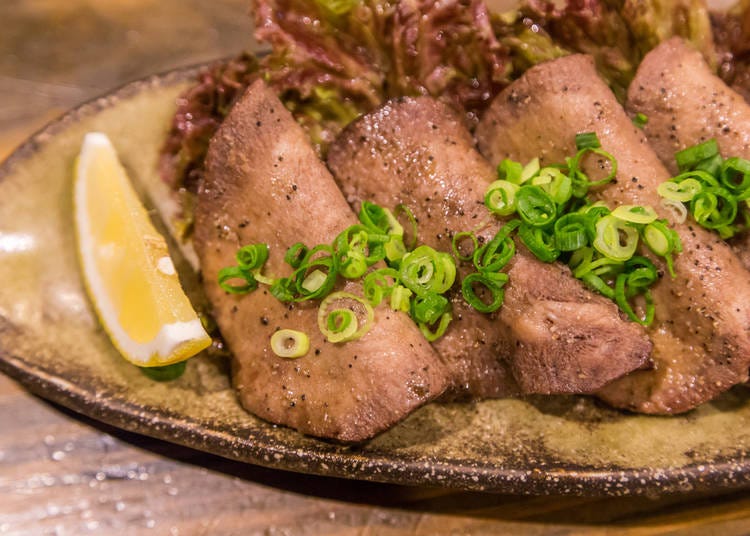
Depending on your state of origin, this dish may appear, at a glance, as well atypical, but bear with us and keep reading.
Gyutan literally ways cow tongue, and this is exactly what the dish is: grilled moo-cow tongue. Y'all tin can normally find this dish in yakiniku restaurants, served with salt or different sauces (usually a lemon one) and scallion. The meat is thin, tasty, and tender.
Gyutan originated in Sendai, where the owner of a yakitori restaurant opened a new one in 1948, which served gyutan. Since then, the dish has spread all over the land like wildfire. Try it, and you'll know exactly why.
9. Karaage
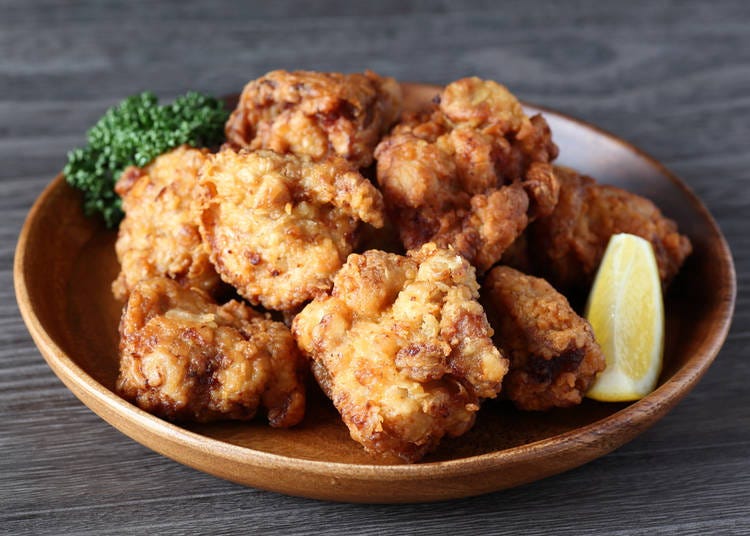
As before long as y'all set foot in Japan, you'll start seeing the typical Japanese fried craven: karaage. At present, karaage usually refers to chicken, but depending on the expanse yous eat out, other meat (like pork) may be used instead.
The pieces of meat are lightly coated with wheat flour or potato starch and deep-fried in oil. Sometimes the ingredients are marinated beforehand. It's usually served with a slice of lemon on the side, simply yous can savor it with or without it.
The chicken variety is especially common in restaurants, street-food carts, izakaya, convenience stores (and pretty much anywhere else). Karaage is inexpensive, tasty, and fast. Only downside? Then skillful, it'south addictive!
10. Katsudon
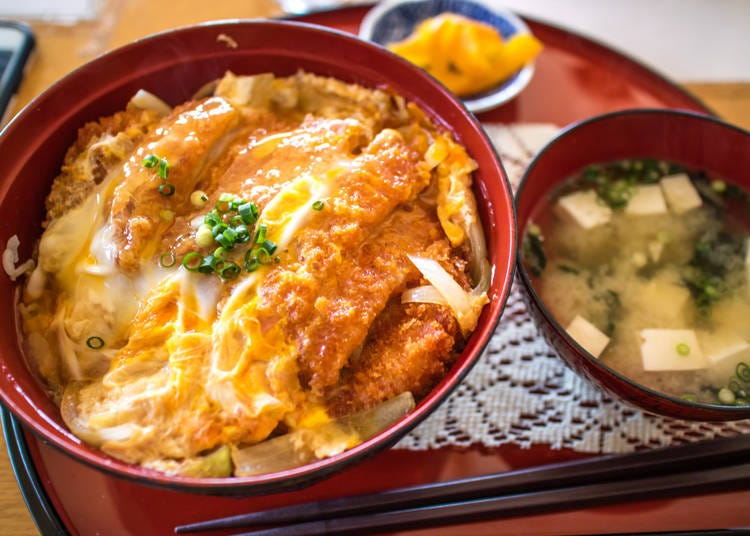
Similar gyudon, but prepared with pork, this is another popular Japanese food and often neglected (past foreigners) dish that is as cheap equally fast and tasty. Perfect for those on the go, y'all can enjoy this repast in specific restaurants and all Japanese-manner fast-nutrient chains. A bowl of rice is served with a topping of deep-fried pork cutlet, egg, vegetables, and condiments.
Information technology's a standard dish in Nippon, but you can detect several kinds, like the i served with tonkatsu sauce, the demi katsudon (a specialty of Okayama), shio-katsudon (flavored with common salt), or the miso-katsu (originally from Nagoya).
Regardless of the variety, you'll honey this dish!
11. Kushikatsu
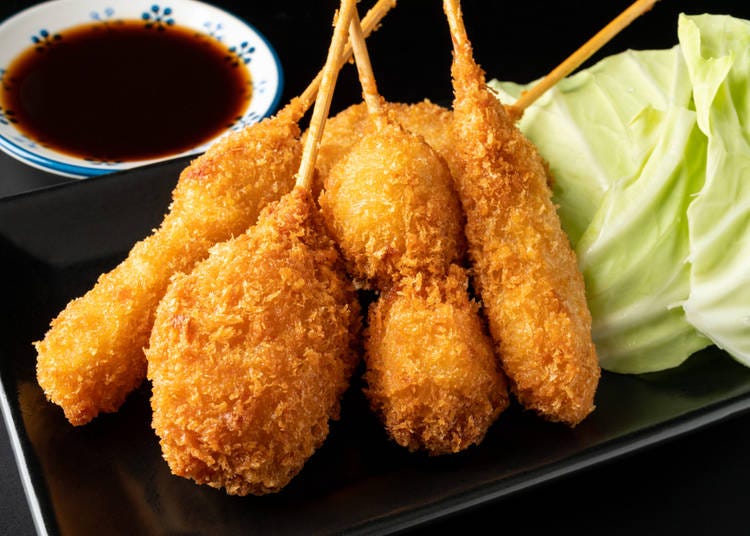
This dish, as well known equally kushiage, is crunchy deep-fried skewered meat, fish, or vegetables. The etymology refers to its preparation, with Kushi referring to the skewers used and katsu, meaning the deep frying of a cutlet of meat.
Some of the more interesting kinds are prepared with bamboo shoots, lotus root, cartilage (nankotsu), and gizzard (sunagimo). They are all certainly worth tasting.
On top of the unlike ingredients that tin be used, there are also several geographical varieties, such equally Osaka; Tokyo (too serving pork rib kushikatsu), where the meat is prepared slightly differently and dressed with dark-brown sauce; Nagoya is famous for its doteni (a rich miso-based dish with beef tendons, offal, and daikon radish. Here you tin can club Kushikatsu with this staple dish. The region also uses different sauces and batter.
12. Miso Soup
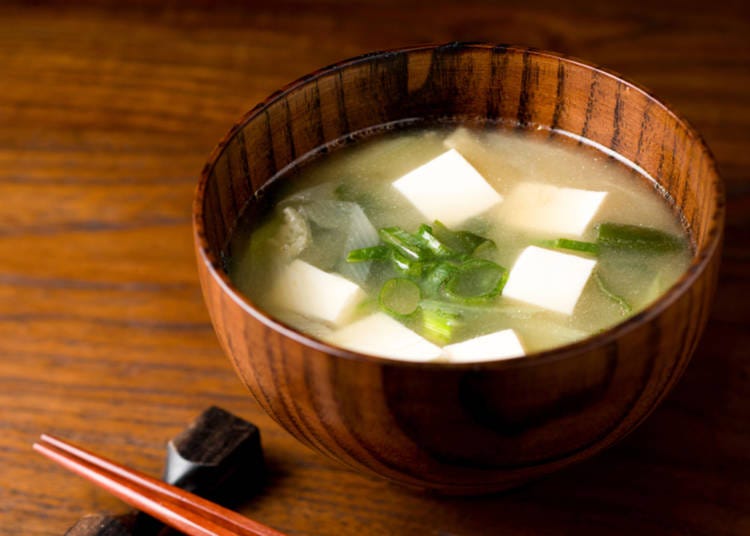
When talking about nutrient in Nihon, we cannot avert mentioning miso soup. This dish served in about any combination of breakfast, tiffin, and dinner meals, is truly a staple of Japanese cuisine. Simple and flavorful, it'southward an amazing side dish to enjoy with the rest of your food.
One time again, we meet dashi being one of the main ingredients. This stock is mixed with miso (seasoning produced by fermenting soybeans) paste, creating the famous soup. Other ingredients are then mixed appropriately to preference.
Very often, miso soup will be served with tofu, scallion, and wakame seaweed. Other items, such every bit daikon, shrimp, fish, mushrooms, potatoes, onions, or meat, can be added.
Specially recommended during cold winter days, you can't leave Japan without trying this evergreen dish!
13. Nabe
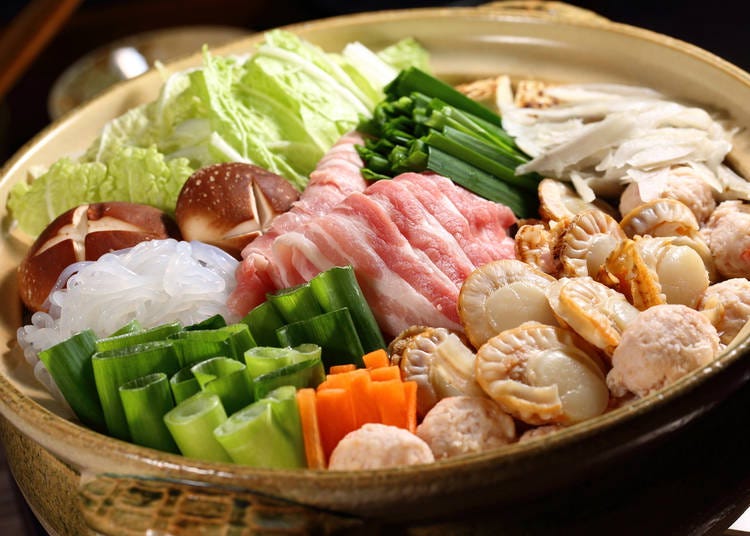
Nabe means cooking pot. It's sometimes referred to every bit nabemono (literally, "things in a cooking pot"). The name already tells y'all everything there is to know most training, but it tin can't begin to pigment a motion picture of the immense variety of nabe one can discover in Japan. This dish can be found all twelvemonth round, but it'due south ideal during cold months.
Popular both in Japanese nabe restaurants and at dwelling, the dish is prepared by boiling in seasoned or unseasoned water a diversity of ingredients: meat, fish, shellfish, vegetables, and tofu.
Nabe is besides famous as the favorite dish of Sumo wrestlers. In particular, when talking about sumo nabe, we are referring to "chanko nabe."
Chanko nabe usually includes meatballs, chicken, vegetables, and noodles. It'south designed to be served with more ingredients for the wrestlers to gain weight.
Another notable name in the nabe family unit is shabu-shabu.
Shabu-shabu's name springs from the movement one makes when dipping thinly sliced meat into the boiling pot. The dish is served with meat (unremarkably beefiness and pork), also equally vegetables and tofu. The food is and then enjoyed with a sesame dipping sauce or ponzu (a lemon-based dressing) or with a mix of the two.
Sukiyaki is a variation of shabu-shabu in which the ingredients are stewed in sweetened water and soy sauce and enjoyed with a dip of raw egg.
Yose nabe (yose=putting together), equally the name implies, is a variety of nabe in which all things, meaning meat, fish, vegetables, and tofu, are cooked together at the same fourth dimension in the pot. It's usually based on a soup of miso or soy sauce.
The types of nabe bachelor in Japan is truly staggering, and so get look for some, experiment, and enjoy!
fourteen. Natto
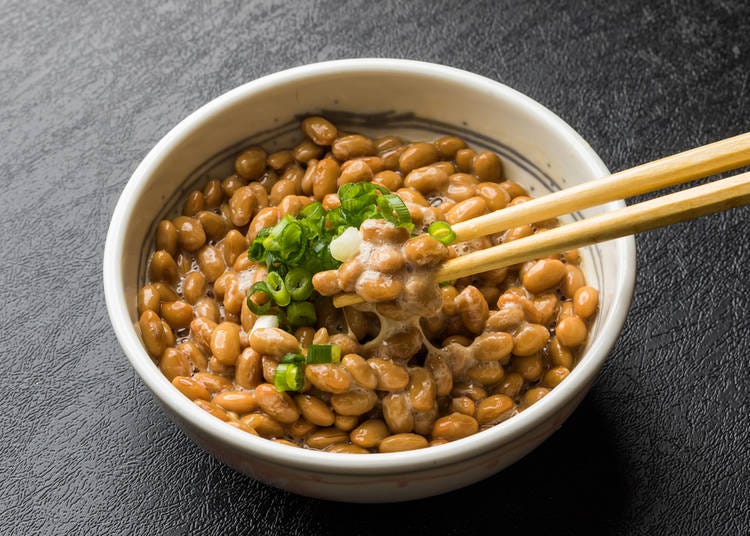
Known as a kind of food disliked by nigh foreigners, natto is daily and widely consumed by most Japanese people.
Many foreigners seem unable to consume natto because these fermented soybeans have a potent smell that most discover unpleasant. Furthermore, its stickiness makes it a little weird for many non-Japanese. Information technology is, though, definitely worth trying, as it'southward truly Japanese food.
Natto is often served with rice (at that place'southward besides a rolled variety you can easily find in convenience stores and sushi restaurants) and dipped in a few drops of soy sauce. Alternatively, it's served with spicy Japanese mustard chosen karashi.
We will acknowledge that it may be difficult to become used to this dish, and it's a bit of an acquired gustatory modality, but we recommend yous give natto a shot, as you may detect you lot accept more of a Japanese palate than you had thought!
15. Oden
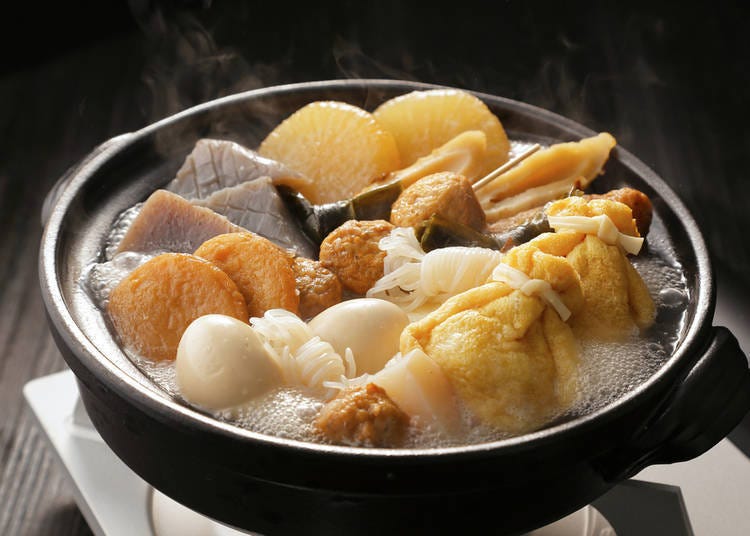
Oden is a tasty, light, hot dish you'd especially enjoy on those cold winter days. This is another variety of one-pot dishes consisting of several ingredients (usually eggs, konjac, fish cakes, and daikon) served in a dashi and soy soup.
While some restaurants specialize in preparing this dish, y'all can usually observe oden in many Japanese fast-nutrient chains and convenience stores.
Oden can exist prepared in many different ways (and sometimes fifty-fifty its proper name is different. In Nagoya, for example, information technology may be called Kanto-ni). The soups in which the ingredients are boiled too change depending on the region.
Oden is a nifty, cheap, and original dish that volition never bore you, especially if you're traveling through dissimilar cities in Japan.
sixteen. Okonomiyaki

If you're visiting the country, you'll want to try one of the many kinds of this staple dish. Difficult to compare to other dishes, okonomiyaki can exist considered the Japanese frittata or pancake.
The etymology of the proper noun itself (meaning what you like or how you lot like + grilled) hints at the number of dissimilar ingredients used to set up this savory dish.
The virtually pop varieties of Okonomiyaki are the ones from the Kansai region and the ones from Hiroshima.
Kansai Okonomiyaki:
This is probably the predominant version of the dish in Japan. The batter is prepared with flour, nagaimo (a kind of yam), dashi (or h2o), eggs, cabbage, pork belly, octopus, squid, shrimp, mochi, or cheese, and konjac.
Osaka is peculiarly renowned, in Kansai, for okonomiyaki, as information technology seems the dish originated from there.
Hiroshima Okonomiyaki:
In this version (as well known as Hiroshima-yaki or Hiroshima-okonomi) the ingredients are not mixed, but bundled in layers. Usually, noodles such as yakisoba, or udon as well as eggs and lots of sauce, are added as a topping.
Many other kinds of this dish exist in several areas across Japan (Tokushima, Hamamatsu, Okinawa, and more).
And if you're visiting Tokyo, you'll have to stop by Tsukishima commune, famous for both okonomiyaki and monjayaki. The main street of Tsukishima has been renamed Monja Street. You will want to visit it to try <@monjayaki|a=article:a0003278/@>, a dish similar to okonomiyaki, just with a less dense texture and with different ingredients.
17. Omuraisu

The name of this flavorful dish derives from the contraction of the words omelet and rice. Omuraisu, as the name suggests, is an omelet filled with fried rice and normally topped with ketchup.
The dish seems to accept originated in Tokyo, in a western-mode restaurant, roughly 100 years ago. You'll observe this dish in most Japanese cafes that also serve food, as well as in several restaurants. If you're staying with friends from Nippon, chances are they'll know how to prepare it, as it's a common dish among Japanese people.
Once again, a filling, cheap, and tasty one-dish meal that will certainly be popular among adult visitors, as well as children!
xviii. Onigiri
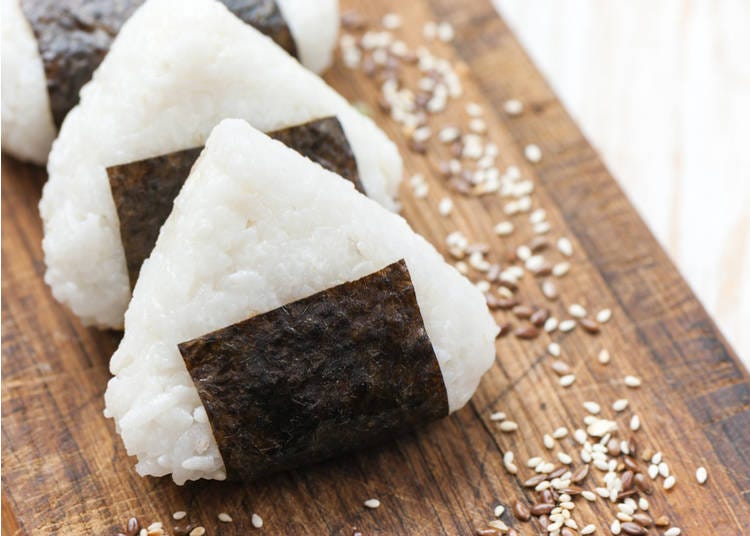
Who hasn't seen in anime, movies, videos, or documentaries the famous Japanese rice brawl, the onigiri? While not very common every bit a menu item in restaurants, this is the king of the on-the-go dishes. You'll find it in about every grocery store and convenience store.
The onigiri can be a simple rice ball flavored with spices, or information technology can be filled (and it ordinarily is) with a diverseness of ingredients from vegetables, to meat, fish, seafood, and more. Information technology'due south sometimes wrapped in a sheet of flavored or unflavored nori (seaweed), depending on the region and one's preference.
Many people visiting Japan eat mainly onigiri while sightseeing given its very inexpensive price (commonly around 100 yen) and its availability and simplicity.
xix. Ramen
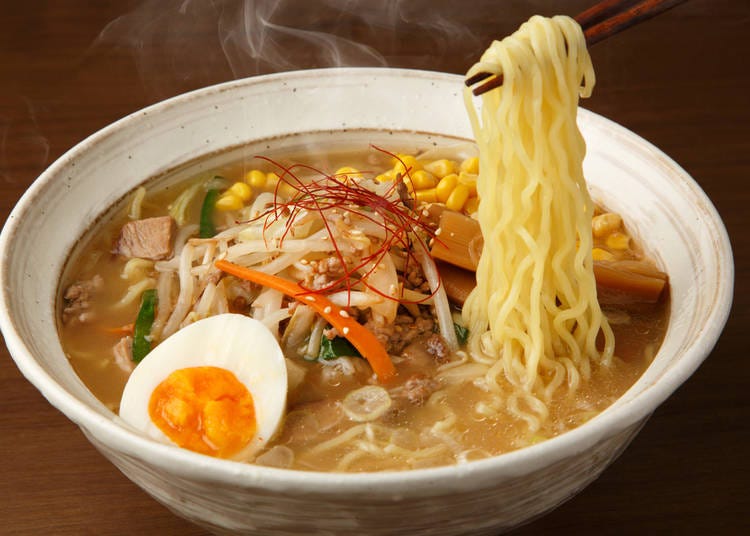
Most people know ramen, peculiarly for its world-famous instant variety, but when in Japan, yous'll be surprised by its amazing taste (definitely not even comparable to its cup counterpart) and the huge amount of unlike choices.
The broth tin can exist based on chicken, pork, beef, fish, vegetables, and flavored with soy sauce, miso, dashi, and many other seasonings. Usually, scallion, seaweed, tofu, and bamboo shoots are added, simply it's impossible to list all the unlike combinations in which this dish can be served.
Not simply each region, but even each restaurant tin have a different recipe, sometimes creating very original and tasty meals.
The noodles are specifically fabricated for ramen and have a very distinctive texture, being soft simply with a chip of a bite.
The nearly common soup stocks are miso, table salt, soy sauce, and curry.
Ramen is probably the almost pop shime (the last meal at the end of a day or nighttime out). It'due south considered to be fast nutrient, and, while some kinds can exist served common cold, it's unremarkably hot, and a godsend on cold days.
20. Robatayaki
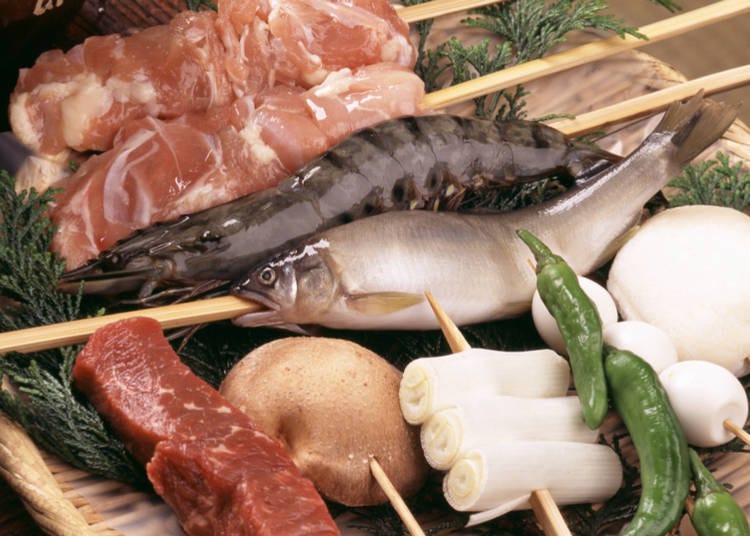
Robatayaki (or robata) is a unique Japanese cuisine in which food is grilled on an irori manner fireplace (broad, flat, open fireplace) over charcoal. This particular dish is usually constitute only in specialized restaurants, and then yous may have to look/ask specifically for it.
The list of food at robata restaurants is everything you can think of, although traditionally it is a combination of seafood and vegetables.
Most visitors miss this astonishing nutrient in Nippon. Make certain yous taste a real piece of Nippon by looking for a good robata (there are many in Tokyo and all over Japan).
21. Soba
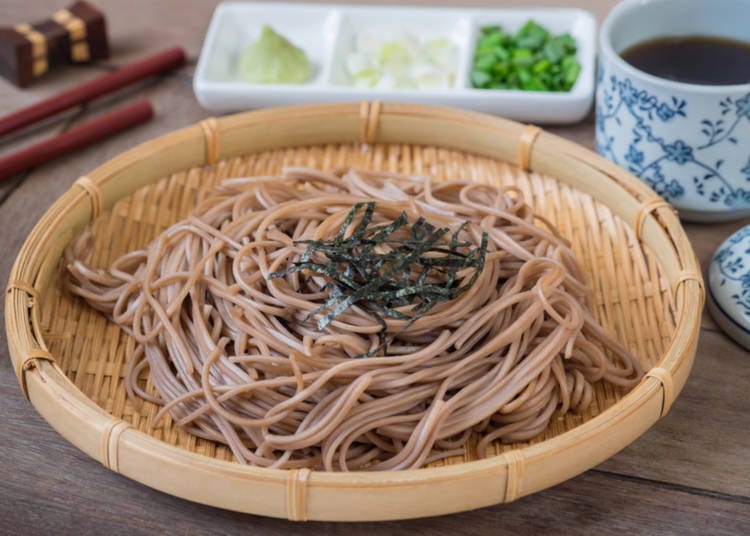
Soba is a buckwheat noodle specialty of Nippon. It's extremely popular, and it's served both in general noodle restaurants and in specialized (often expensive) ones.
Information technology'south also relatively unproblematic to prepare at dwelling house, past getting the noodles and the soup in which they are dipped at a grocery shop.
Soba can be enjoyed in a common cold dip, or in a broth, equally a noodle soup.
This dish appears in dissimilar varieties depending on the season and the region you're visiting. Don't forget to ask for a soba dish adjacent time you lot visit a restaurant in Nihon!
22. Somen
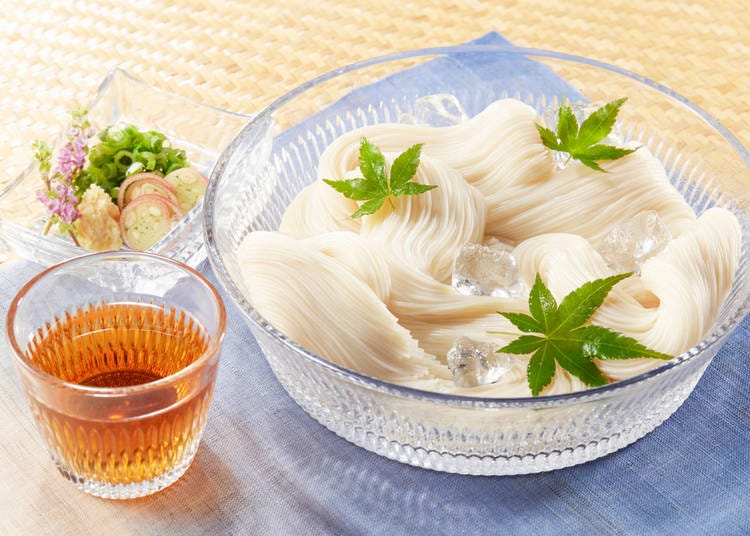
Somen is the Japanese version of a prevalent kind of noodles across Asia. Made out of wheat flour, it'southward usually served cold. These skinny noodles are served with a simple cold dipping sauce, or with a sauce flavored with onion, ginger, and myoga (a different kind of ginger).
This dish is particularly popular in summer when a dish of somen chilled with water ice cubes is all y'all need to recharge, fill up up, absurd off, and take a intermission from the vicious Japanese summer oestrus.
23. Sushi and sashimi

Of course, we all know these dishes, but nosotros can't avoid mentioning them in this guide. Sushi and sashimi are amongst the foods at the summit of Japanese cuisine.
While very famous worldwide, many neglect to understand the multifariousness of cuts and preparation that tin go into preparing this food. Sushi chefs are regarded equally artists, and most of them have to practice as apprentices for years (and at times decades) before they too can exist called sushi and sashimi masters.
This doesn't hateful that it'due south impossible to find skilful quality sushi or sashimi at a off-white price. Japan offers options for all palates and all pockets.
An enjoyable experience is that of the rolling sushi restaurants. You social club from a small tablet at your table, and the sushi is served direct to yous via a rolling mat. The food is fantabulous, and it's only 100 yen per dish (these restaurants are usually called 100 yen-sushi, or sushiro).
Something missing outside of Nihon is unremarkably the then-chosen temaki zushi (lit. hand-rolled sushi). Y'all can certainly find restaurants in which this dish is served, but you'll love making your ain at abode (if you lot have Japanese friends, information technology's pretty much guaranteed they'll know how to do it). The preparation is unproblematic. You'll demand sushi rice, cuts of your favorite fish (thin slices, usually), body of water weed sheets, and whatsoever other ingredients you'd like to add together, according to your taste. Oftentimes used ingredients are cucumber, crab, avocado, and wasabi.
Spread the rice on a sheet of seaweed, add fish and other fillings, roll the seaweed in a cylinder or cone, and bask with soy sauce.
If y'all're in Japan, propose a "temaki zushi party," and you'll surely get amazing approval.
24. Takowasa

Takowasa is raw octopus (tako) served in a wasabi sauce (wasa). This is one of those Japanese dishes that, depending on your cultural groundwork, may announced weird. Do try information technology out!
Takowasa is a mutual appetizer in many restaurants, and especially in izakaya. Information technology's very pop and for a proficient reason. It'due south tasty, unique, and a truthful symbol of Japanese popular food tradition.
25. Tempura
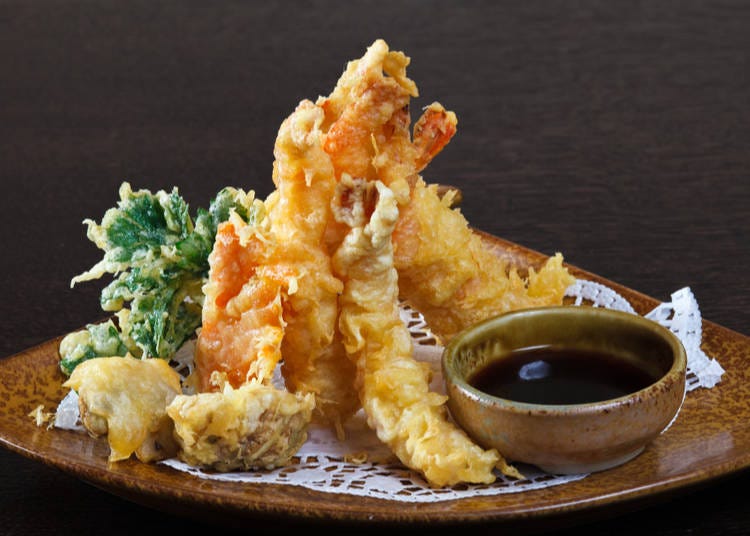
Tempura is a great dish all year round, especially for those of you lot who enjoy sharing a few drinks with friends.
Tempura consists of shellfish, fish, chicken, or vegetables covered in a flavorful batter and deep-fried until they reach a perfect crunchiness level.
You can relish tempura as is or with dipping sauce.
While many restaurants serve this dish, several specialize in it, where you can find a wider choice for an even more amazing dive into traditional Japanese food.
26. Teppanyaki
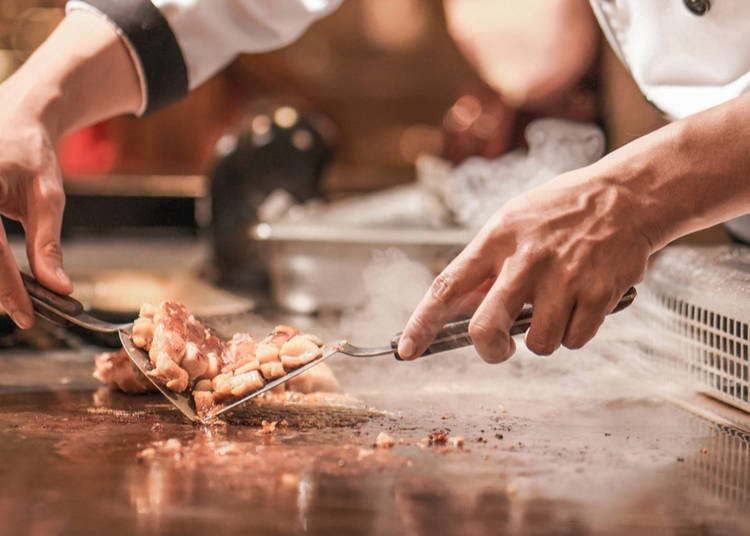
Teppanyaki is one of the less known (but however delicious) styles of Japanese cooking. Teppan means iron plate, and yaki means grilled.
Teppanyaki is a term that encompasses a large variety of dishes, including okonomiyaki, yakisoba, and monjayaki. Still, it'south usually used to refer to a particular kind of preparation of western-influenced food.
Typical ingredients for teppanyaki are beef, shrimp, vegetables, chicken, and scallops. They are prepared on a hotplate, usually with soybean oil.
Some of you may be familiar with this kind of cooking, as in the U.S., these restaurants are pretty popular (although known equally hibachi).
If you come up to Japan and you lot want to taste amazing food that espouses Nihon and the west, y'all'll actually want to requite teppanyaki a shot.
27. Tonkatsu

Tonkatsu is a acme-rated and like shooting fish in a barrel to find dish of breaded pork cutlet deep fried in vegetable oil.
You can find this cheap, tasty dish in several chain restaurants and in bento boxes in grocery and convenience stores. You tin even make information technology yourself!
Flavor the meat with salt and pepper and encompass it with flour. Then dip it into the beaten egg and add a layer of panko (Japanese flaky bread crumbs). Deep fry, and serve with cabbage, murphy salad, and some brown sauce or karashi.
Tonkatsu is also perfect for on-the-go sandwiches, making for a great quick repast.
28. Udon
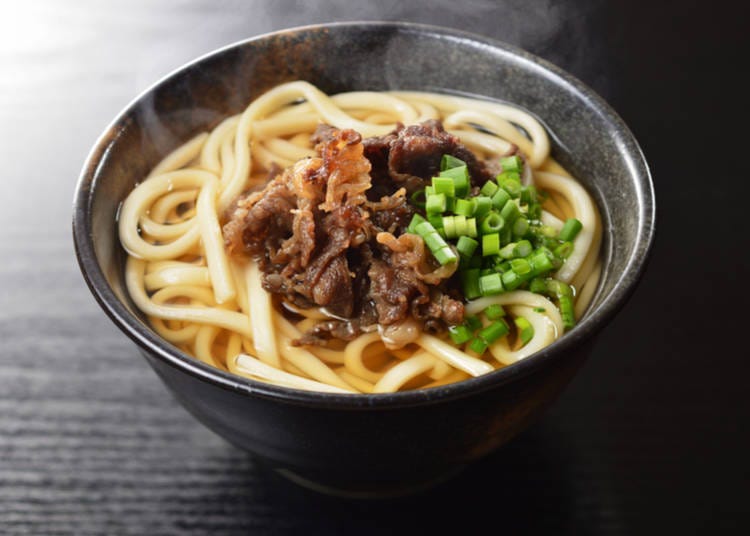
Of the huge variety of noodles you can find in Nihon, udon, similarly to ramen, is one of the almost pop. Udon is a thick wheat flour noodle that you can enjoy in its simplest grade (broth fabricated of dashi, mirin and soy sauce), or in a variety of combinations.
Try it with tempura, for a robust repast, or with tofu, for a more frail taste.
Udon can be served hot or cold, depending on the season (and on one'southward taste) and it'south prepared in many styles depending on the region yous're visiting.
While the word udon refers to the noodles themselves, there's no limit to the flavors, soups, and ingredients that can be added. As a matter of fact, challenge yourself to try out every bit many styles of udon equally you tin during your visit in Nippon, and non only are you going to be satisfied, but also nowhere near the terminate of the list of possible dishes!
29. Yakiniku
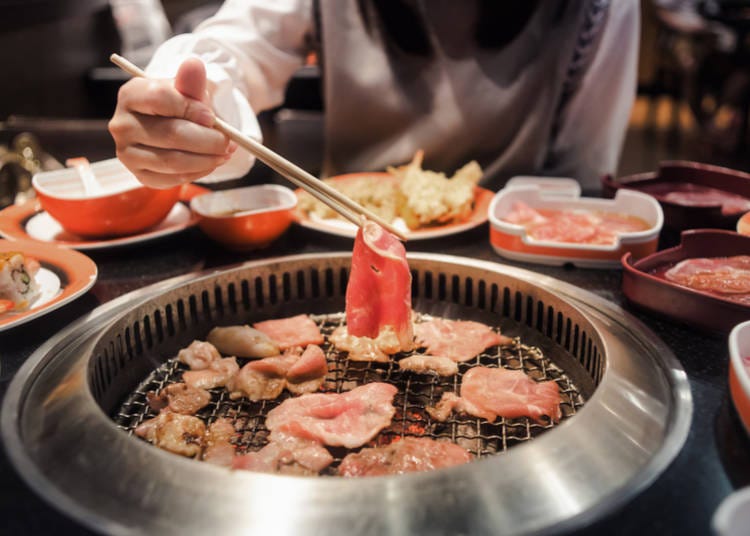
Yakiniku means grilled meat and can also exist referred to as Korean charcoal-broil or Japanese barbecue. (The chief difference is that for Korean style barbecue, meats are typically marinated, while in the Japanese fashion, they are not.)
Yakiniku restaurants are wildly popular and you can discover many high-stop ones, as well as more budget-friendly ones (many of which also offer all-you lot-can-eat menus).
In yakiniku restaurants, you order the meat or vegetables that you prefer (seasoned or unseasoned). The choice is huge. And so you grill it yourself on a hot plate or grill usually embedded inside the table. You tin then add sauces such as lemon, bbq, and many others, or merely table salt and pepper.
thirty. Yakisoba
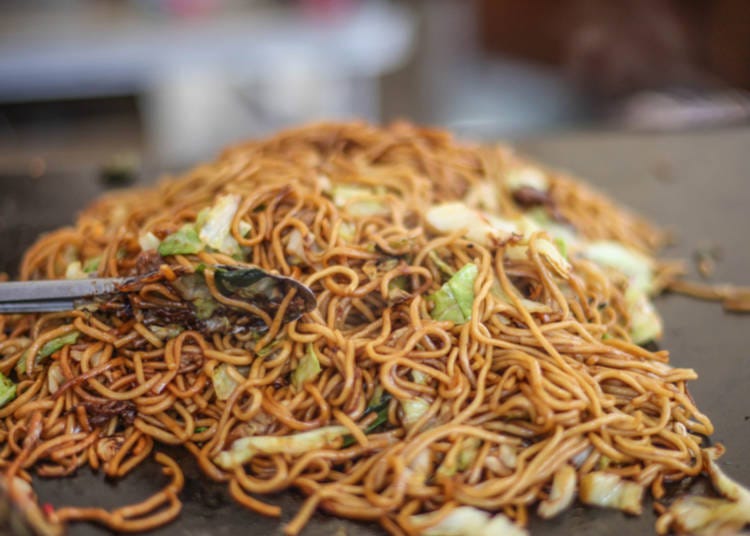
Yakisoba as the name suggests is a multifariousness of grilled soba (or noodles in general) and is a dish typically establish at festivals. You lot can as well gear up yakisoba past stir-frying the noodles. You lot can add pork, fish, or vegetables and garnish with seaweed powder, ginger, and fish flakes. Give a finishing touch with sauces such as oyster sauce and thank u.s.a. later!
31. Yakitori
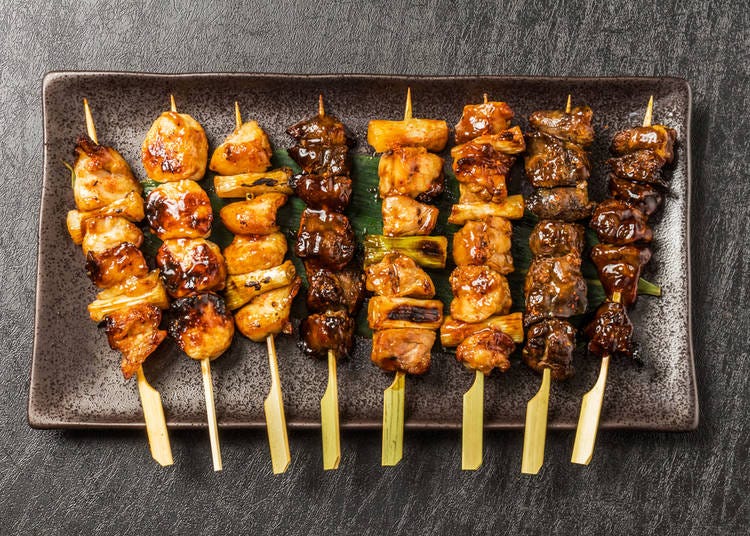
Although the word yakitori literally means grilled chicken, this concept encompasses all kinds of skewered meat (and vegetables) prepared on a grill. This is a simple and flavorful dish with a never-ending list of combinations, found in several restaurants and specialty shops. When visiting a skillful izakaya, it is especially recommended to experience some other i of the true popular Japanese foods.
32. Yakizakana
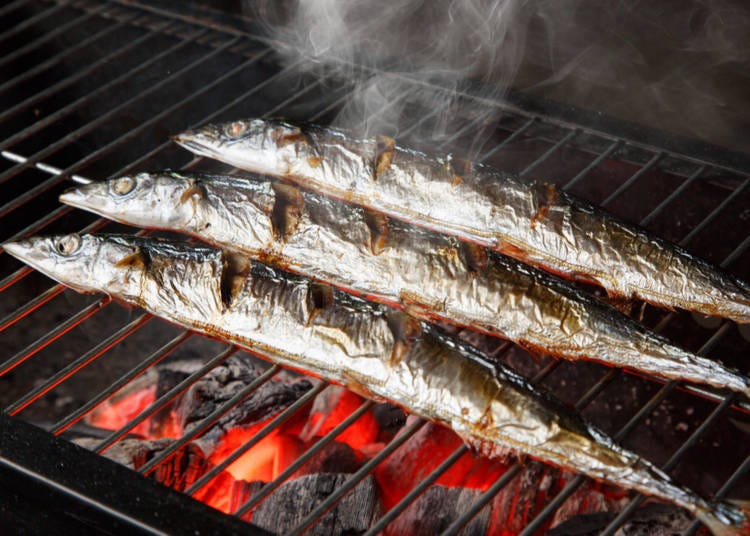
Being in Nippon, we can't leave out grilled fish.
Yakizakana may not be as popular as sushi outside of Japan, only it'due south arguably much more mutual than raw fish in this land.
Unremarkably, a whole fish is grilled and served with side dishes of various vegetables and rice. Try it in specialized restaurants for a fully immersive experience or in chain restaurants for a tasty, cheap, and fast meal that will keep yous going for the several hours of sightseeing ahead of you!
Yous're at present on the way to get a truthful expert on food in Japan! Yet there's much more than to Japanese cuisine that tin can be discovered! While visiting this astonishing country and taking in all the sights, the fun, and the civilization, don't forget to eat!
Written by:

*This information is from the time of this commodity's publication.
*Prices and options mentioned are field of study to modify.
*Unless stated otherwise, all prices include tax.
Source: https://livejapan.com/en/in-tokyo/in-pref-tokyo/in-tsukiji/article-a0002670/
0 Response to "Customer Eats Sushi and Maybe Eat Sushi Again After It Nearly Waalks Off the Plate"
Post a Comment